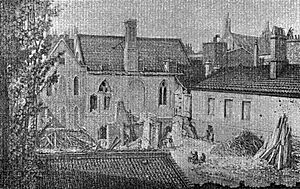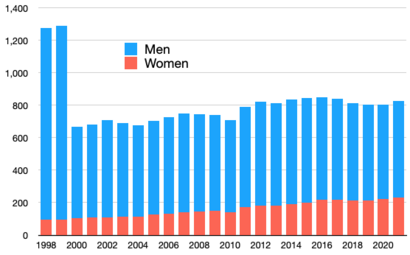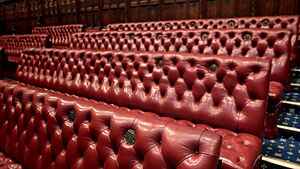House of Lords facts for kids
Quick facts for kids The House of Lords |
|
|---|---|

Logo of the House of Lords
|
|
| Type | |
| Type | |
| Leadership | |
|
Lord Speaker
|
The Lord McFall of Alcluith
Since 1 May 2021 |
|
Senior Deputy Speaker
|
The Lord Gardiner of Kimble
Since 11 May 2021 |
|
The Baroness Smith of Basildon, Labour
Since 5 July 2024 |
|
|
The Lord True, Conservative
Since 8 July 2024 |
|
|
Government Chief Whip
|
The Lord Kennedy of Southwark, Labour
Since 10 July 2024 |
| Structure | |
| Seats | 777 |
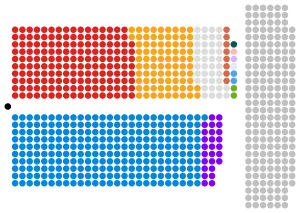 |
|
|
Political groups
|
Lords Spiritual
|
|
Length of term
|
|
| Salary | No annual salary, but tax-free daily allowance and expenses paid. |
| Meeting place | |
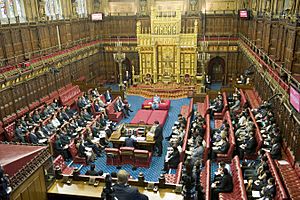 |
|
| House of Lords Chamber Palace of Westminster, London |
|
The House of Lords is the second chamber of the Parliament of the United Kingdom. It is often called the "upper house." Like the House of Commons (the "lower house"), it meets in the Palace of Westminster in London, England. The House of Lords is one of the oldest parts of the UK government, with roots going back to the 11th century.
Unlike the House of Commons, most members of the Lords are not elected by the public. Instead, they are usually chosen for life. These members are called life peers. Since 1999, only 92 hereditary peers (people who inherited their titles) can be members. These 92 are chosen through special elections among themselves. The House of Lords also includes up to 26 archbishops and bishops from the Church of England, known as Lords Spiritual. Since 2014, members can choose to leave or be removed if they break rules.
The House of Lords has important jobs, similar to the House of Commons. It checks new laws, makes sure the government is doing its job, and looks at public policy. Members can also suggest new laws or changes to bills. While the Lords cannot usually stop a bill from becoming law, they can delay it for up to one year. This role helps the House of Lords act as a "revising chamber." It means they carefully check the details of new laws and sometimes ask the House of Commons to think again.
Members of the Lords can also be government ministers, but usually only in junior roles. The House of Lords does not control who is Prime Minister or when an election happens; only the Commons can do that. The number of members in the House of Lords is not fixed. As of 10 December 2025, there are 777 members. The House of Lords is the only upper house in the world that is larger than its lower house. It is also the second-largest law-making body in the world, after China's National People's Congress.
The King's Speech is given in the House of Lords chamber at the start of each new parliamentary year. Before 2009, the House of Lords also acted as the highest court in the UK through its Law Lords. This role is now handled by the Supreme Court of the United Kingdom. The House of Lords also has a role with the Church of England, as Church laws (called "Measures") must be presented there by the Lords Spiritual.
Contents
History of the House of Lords
The UK Parliament today comes mostly from the old Parliament of England. After Scotland and England joined together in 1707, a new Parliament of Great Britain was formed. This new parliament was basically the old English Parliament, but with members from Scotland added.
Early Beginnings
The House of Lords grew from the "Great Council" (Magnum Concilium). This council advised the king in medieval times, starting around the 11th century. It included church leaders, noblemen, and representatives from different areas of England and Wales. The first English Parliament is often thought to be either Simon de Montfort's Parliament (in 1265) or the "Model Parliament" (in 1295). These included archbishops, bishops, abbots, earls, barons, and local representatives.
Parliament's power grew slowly. Sometimes it was stronger, sometimes weaker, depending on how strong the king was. For example, during the reign of Edward II (1307–1327), the nobles were very powerful, the king was weak, and the local representatives had no power at all.
Under King Edward II's successor, Edward III, Parliament clearly split into two separate groups: the House of Commons (with local representatives) and the House of Lords (with church leaders and nobles). Parliament's power kept growing. In the early 15th century, both Houses had more power than ever before. The Lords were much more powerful than the Commons because of the great influence of the wealthy landowners and church leaders.
The power of the nobles decreased during the civil wars of the late 15th century, known as the Wars of the Roses. Many nobles were killed or lost their lands. Also, the old system of feudalism was ending, and the armies controlled by barons became outdated. Henry VII (1485–1509) made the monarch (the king or queen) supreme. The king's power continued to grow under the Tudor monarchs in the 16th century, reaching its peak with Henry VIII (1509–1547).
The House of Lords stayed more powerful than the House of Commons for a while. However, the Commons kept gaining influence, especially in the mid-17th century. Arguments between the King and Parliament (mostly the House of Commons) led to the English Civil War in the 1640s. In 1649, after King Charles I was defeated and executed, England became a Commonwealth. The country was mostly controlled by Oliver Cromwell, the Lord Protector.
The House of Lords lost almost all its power. Cromwell and his supporters in the Commons ran the government. On 19 March 1649, an Act of Parliament officially abolished the House of Lords. It said the Lords were "useless and dangerous to the people of England." The House of Lords did not meet again until 1660, when the monarchy was brought back. It then returned to its position as the more powerful part of Parliament, a role it kept until the 19th century.

Changes in the 19th Century
The 19th century brought many changes to the House of Lords. The House, which once had only about 50 members, grew much larger. Kings like George III created many new peerages (titles of nobility). This meant that the influence of each individual Lord became smaller.
Also, the power of the House of Lords as a whole decreased, while the House of Commons became stronger. A key event was the Reform Act of 1832. The way members were elected to the House of Commons was unfair. Only a few people could vote, and the areas they represented (constituencies) had not changed for centuries. Big cities like Manchester had no representatives, while tiny places with only a few voters could still elect two MPs. Some rich aristocrats controlled many of these "pocket boroughs," giving them a lot of power in the Commons.
When the House of Commons passed a Reform Bill in 1831 to fix these problems, the House of Lords rejected it. But the government did not give up. After the bill was rejected a second time in 1832, Prime Minister Charles Grey, 2nd Earl Grey suggested to the King that he create about 80 new peers who supported the reform. King William IV did not like this idea at first, as it would force the Lords to agree. But he eventually gave in.
Before the new peers were created, the Lords who opposed the bill saw they were defeated. They chose not to vote, allowing the bill to pass. This crisis weakened the political power of the House of Lords. In 1868, the Lords themselves made an important change: they stopped members from voting without actually being present. Over the century, the Lords' powers were reduced step by step, leading to the Parliament Act 1911 in the 20th century. The Commons slowly became the stronger House.

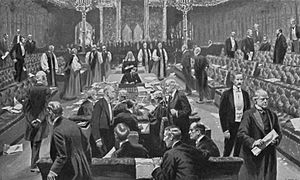
The 20th Century and Beyond
The role of the House of Lords became a big topic again after the Liberal Government was elected in 1906. In 1909, the government proposed a "People's Budget" which included a new tax on wealthy landowners. This popular idea was defeated by the House of Lords, which had many Conservative members.
The Liberals were re-elected in January 1910, having made the Lords' powers a main issue in their campaign. Prime Minister H. H. Asquith then suggested that the Lords' powers should be greatly reduced. After another election in December 1910, and with a promise from King George V to create enough new Liberal peers if needed, the government passed a bill to limit the Lords' powers. The Parliament Act 1911 meant the House of Lords could no longer reject most laws, or change them in ways the Commons did not like. They could only delay most bills for up to one year. This was meant to be a temporary fix, with more changes planned later. However, neither main political party pushed for more reforms with much energy.
The Parliament Act 1949 further reduced the Lords' power to delay bills to just one year. In 1958, the Life Peerages Act 1958 allowed the creation of life peerages (titles that cannot be inherited). This meant more people could become members of the Lords without inheriting a title. The number of life peers slowly grew.
For most of the 20th century, the Labour Party wanted to get rid of the House of Lords, or at least remove the hereditary members. In 1968, the Labour government tried to reform the Lords. Hereditary peers would stay but could not vote. This plan failed. When Michael Foot became Labour leader in 1980, abolishing the Lords became part of the party's goals. Later, under Neil Kinnock, a reformed upper house was suggested instead.
21st Century Reforms
In 2020, the government thought about moving the House of Lords from London to a city in Northern England or the Midlands. This was to try and "reconnect" with those areas. Many members of the Lords did not like this idea.
Removing Hereditary Peers
As democracy grew in the UK, the House of Lords, with its many inherited titles, seemed old-fashioned. Many attempts have been made to change it. The most important change was in 1999, when most hereditary peers were removed. The Labour Party's plan for 2024 is to get rid of the House of Lords and replace it with an elected second chamber.
First Women Members
No women were members of the House of Lords until 1958. The Life Peerages Act 1958 allowed women to become life peers. Four women were among the first life peers chosen. However, women who had inherited peerages still could not sit until the Peerage Act 1963. Since the House of Lords Act 1999, female hereditary peers can be elected to the House.
Changes in the New Labour Era
The Labour Party promised in its 1997 election plan to remove hereditary peers from the House of Lords. After they won the election, the Labour government introduced a law to remove all hereditary peers. However, as a compromise, 92 hereditary peers were allowed to stay until further reforms were made. So, the House of Lords Act 1999 removed most hereditary peers, making the House of Lords mainly a chamber of appointed members.
Since 1999, no major further reforms have happened. In 2003, members of the House of Commons voted on different ways to make the Lords more elected. An option for 80% elected members almost passed. In 2007, the Commons voted again, and the idea of an 80% elected Lords won, as did a fully elected Lords. But these were just votes to show what MPs wanted, and the Lords later rejected these ideas.
In 2008, the government suggested replacing the House of Lords with an 80–100% elected chamber. Members would be elected for a single term of about 12–15 years. The paper also suggested changing the name to the "Senate of the United Kingdom."
Recent Changes (2010–Present)
After the 2010 election, the Conservative–Liberal Democrat government agreed to plan for a mostly or fully elected second chamber. In 2011, detailed proposals were published for a 300-member house, with 80% elected and 20% appointed. Some Church of England bishops would also remain. Elected members would serve a single 15-year term.
The proposals included:
- The upper chamber would still be called the House of Lords for making laws.
- It would have 300 members: 240 elected and 60 appointed. Up to 12 Church of England bishops could also sit.
- Elected members would serve one 15-year term.
- Elections would happen at the same time as House of Commons elections.
- Elected members would be chosen using a system called Single Transferable Vote.
- Appointed members would be chosen by the King based on advice from the Prime Minister and an Appointments Commission.
- Being a peer (having a title) would no longer automatically mean you are a member of the House of Lords.
- The House of Lords' powers would not change, and the House of Commons would remain the main House.
These plans were discussed by a special committee. In 2012, a new bill was introduced, but it was dropped due to opposition from within the Conservative Party.
House of Lords Reform Act 2014
A new law, the House of Lords Reform Act 2014, was passed in 2014. This law allowed:
- All peers to retire or resign from the House.
- Peers to be removed for not attending meetings.
- Peers to be removed if they receive a prison sentence of a year or more.
Lords Spiritual (Women) Act 2015
This Act made it easier for women bishops of the Church of England to become Lords Spiritual. For 10 years (2015-2025), if a spot for a Lord Spiritual opens up, it must be filled by a woman bishop if one is eligible. In 2015, Rachel Treweek, the Bishop of Gloucester, became the first woman to sit as a Lord Spiritual because of this Act.
Size of the House of Lords
The number of members in the House of Lords has changed a lot over time. After England and Scotland joined in 1707, the first Parliament of Great Britain had 184 nobles. When Ireland joined in 1801, another 28 Irish members were added. The House kept growing. In October 1999, it reached a record size of 1,330 members. After the House of Lords Act 1999 removed most hereditary peers, the number dropped to 669 by March 2000.
However, the number of members grew again in the following years, reaching over 800 active members by 2014. This led to more reforms in the House of Lords Reform Act 2014. In 2014, even though there are only about 230 to 400 seats in the chamber, the House had 774 active members. This made the House of Lords the largest parliamentary chamber in any democracy. In 2014, former Speaker of the House of Commons, Betty Boothroyd, suggested that "older peers should retire gracefully" to help with overcrowding.
In 2016, a committee was formed to look at the overcrowding issue. In 2017, it suggested limiting membership to 600 peers, with new peers serving a 15-year term. By April 2019, the number of active peers had dropped to 782, but this was still more than the 669 members after the 1999 reforms. It is also still larger than the House of Commons, which has 650 members.
What the House of Lords Does
Making Laws
Most new laws, except for those about money (like taxes), can start in either the House of Lords or the House of Commons.
The House of Lords discusses new laws and can suggest changes or even reject them. However, their power to reject a bill passed by the House of Commons is very limited by the Parliament Acts. For example, the House of Lords cannot delay a "money bill" (a bill about national taxes or public money) for more than one month.
Other public bills cannot be delayed by the House of Lords for more than two parliamentary sessions, or one calendar year. These rules only apply to bills that start in the House of Commons. There is also a rule called the Salisbury Convention. This means the House of Lords usually does not oppose laws that were promised by the government in their election plans.
The House of Lords also cannot start any bill about taxes or government spending. They also cannot change a bill to add parts about taxes or spending.
Past Role as a Court
Historically, the House of Lords had several jobs as a court. Most importantly, until 2009, the House of Lords was the highest court for most legal cases in the UK. This role is now held by the Supreme Court of the United Kingdom.
The Lords' court duties were carried out by a special group of members called "Law Lords." These Law Lords were chosen specifically for this job. They would retire from their judicial role at age 75. By tradition, Law Lords did not take part in debates about new laws, to keep their independence as judges.
The House of Lords heard appeals from courts in England, Wales, and Northern Ireland. For Scotland, they only heard civil (non-criminal) cases. The House of Lords was not the only highest court; the Judicial Committee of the Privy Council also had some court duties.
The Constitutional Reform Act 2005 created the separate Supreme Court of the United Kingdom. This court took over the judicial role of the House of Lords. The main reason for the new Supreme Court was to clearly separate the powers of the judges from the powers of those who make laws. Because of this, judges appointed to the Supreme Court are now not allowed to sit or vote in the House of Lords until they retire as judges.
The House of Lords also used to try impeachments (serious charges brought by the House of Commons) and try peers (nobles) accused of serious crimes like treason. However, these roles are now very rare or no longer happen. The last impeachment was in 1806, and the right for peers to be tried in special courts was abolished in 1948.
Who are the Members?
Lords Spiritual
Members of the House of Lords who are there because of their church positions are called Lords Spiritual. In the past, they were the majority in the English House of Lords. They included archbishops, bishops, and abbots. After the English Reformation in the 16th century, only archbishops and bishops continued to attend. They were removed for a time in 1642 but returned in 1661.
Today, there can be no more than 26 Lords Spiritual. These are the Archbishops of Canterbury and York, the Bishops of London, Durham, and Winchester (who always sit). The other 21 are the longest-serving archbishops and bishops from other parts of the Church of England.
The current Lords Spiritual only represent the Church of England. Other church leaders have sat in the House of Lords as "Lords Temporal" (non-church members) in recent times. For example, the Chief Rabbi of the United Synagogue and the Anglican Archbishop of Armagh (from Ireland) have been appointed.
By tradition, at least one of the archbishops or bishops reads prayers each day the House meets. They also often speak in debates.
Lords Temporal
The Lords Temporal are the largest group in the House of Lords. Unlike the Lords Spiritual, they can openly support political parties. Those who do not belong to a political party are called crossbenchers.
Hereditary Peers
Originally, the Lords Temporal included hundreds of hereditary peers. These were people who inherited their titles (like dukes, marquesses, earls, viscounts, and barons). New hereditary titles can be created by the King or Queen, usually on the advice of the Prime Minister.
When Scotland joined England in 1707, Scottish hereditary peers could only elect 16 of their own to sit in the House of Lords. When Ireland joined in 1801, Irish peers could elect 28 members. Elections for Irish representatives ended in 1922 when most of Ireland became independent. Elections for Scottish representatives ended in 1963, when all Scottish peers gained seats in the House.
In 1999, the Labour government passed the House of Lords Act. This law removed the right of most hereditary peers to sit in the House. As a temporary measure, 92 hereditary peers were allowed to remain.
Of these 92, two are there because they hold special royal jobs connected to Parliament: the Earl Marshal and the Lord Great Chamberlain. The other 90 are elected: 15 are chosen by the whole House, and 75 are chosen by hereditary peers from their own political groups. When an elected hereditary peer dies, a special election is held to replace them.
Life Peers
The largest group of members in the House of Lords are life peers. As of 2024, there are 670 life peers who can vote. Life peers are created under the Life Peerages Act 1958. They are appointed by the King or Queen, usually on the advice of the Prime Minister or the House of Lords Appointments Commission. The Prime Minister usually allows leaders of other parties to suggest some life peers, to keep a balance of political views in the House. Some non-party life peers are also suggested by an independent commission.
In 2000, the government set up an Independent Appointments Commission to choose "people's peers." These were meant to be ordinary people, but the choices were often distinguished in their fields.
Who Can Be a Member?
To be a member of the House of Lords, a person must be at least 21 years old. They must also be a citizen of the United Kingdom, Ireland, or a Commonwealth country. People who are bankrupt or have been convicted of high treason cannot sit in the House of Lords. If someone is serving a prison sentence of a year or more for a crime, they also lose their seat.
Women were not allowed in the House of Lords until the Life Peerages Act 1958. This law allowed women to become life peers. In 1963, women who had inherited peerages were also allowed to join.
Donations and Appointments
It is against the law to buy or sell a peerage or other honour. However, there have been claims that life peerages (and thus membership in the House of Lords) have been given to people who make large donations to political parties. A study in 2015 found that many people appointed to the Lords who were not already in public life had made significant donations to political parties.
Leaving the House
Before 2014, there was no way for members to resign or be removed from the House of Lords. The Peerage Act 1963 allowed people to give up (disclaim) an inherited peerage if they wanted to sit in the House of Commons instead.
The House of Lords Reform Act 2014 changed this. It allowed members to resign, be removed for not attending, or be automatically expelled if convicted of a serious crime with a jail sentence of at least one year. The House of Lords (Expulsion and Suspension) Act 2015 also allows the House to suspend or expel members for bad behaviour.
Officers of the House
The House of Lords used to have the Lord Chancellor as its speaker. But with the Constitutional Reform Act 2005, a new role called Lord Speaker was created. A peer is elected by the House to this position. The first Lord Speaker was Helene Hayman, Baroness Hayman. The current Lord Speaker is John McFall, Lord McFall of Alcluith.
The Lord Speaker is expected to be fair and not take sides. The Lord Speaker or their deputies sit on the Woolsack, a large red seat stuffed with wool, at the front of the Lords Chamber.
The Lord Speaker has less power than the Speaker of the House of Commons. The Lord Speaker mainly announces the results of votes. Unlike in the Commons, members in the Lords speak to the whole House ("My Lords") rather than to the Speaker. The Lord Speaker cannot tell members when to speak or punish them for breaking rules; only the House itself can do that.
Another important officer is the Leader of the House of Lords. This peer is chosen by the Prime Minister. The Leader is in charge of guiding government bills through the House of Lords and is part of the Cabinet.
The Clerk of the Parliaments is the chief clerk and officer of the House of Lords. They advise on rules, sign official papers, and keep records. The Gentleman or Lady Usher of the Black Rod is responsible for ceremonies and keeping order in the Chamber.
How the House Works
The House of Lords and the House of Commons meet in the Palace of Westminster. The Lords Chamber is very grand and decorated, unlike the simpler Commons Chamber. The benches in the Lords Chamber are red. The government members sit on the right of the Woolsack, and opposition members sit on the left. Members who do not belong to a party (crossbenchers) sit opposite the Woolsack.
The Lords Chamber is where many important ceremonies happen, like the State Opening of Parliament. During this event, the King or Queen sits on the Throne in the Lords Chamber. With both Houses present, they give a speech outlining the government's plans for the year.
In the House of Lords, members do not need to be called on by the speaker before they talk. If two or more members stand up at the same time, the House decides who speaks. Speeches in the House of Lords are not limited by time. However, the House can vote to stop a speech or end a debate.
After all speeches on a topic are finished, the House votes. First, they vote by voice vote. The Lord Speaker asks members to say "content" (yes) or "not content" (no). If anyone challenges the voice vote, a recorded vote called a division happens.
Members go into one of two lobbies (rooms) on either side of the Chamber. Their names are recorded, and their votes are counted. The Lord Speaker does not vote. The results are then announced to the House. For a vote on a law to be valid, at least 30 members must be present. For other votes, only three members are needed.
During the 2020 COVID-19 pandemic, special arrangements were made to allow some duties to be done online.
Rules for Behaviour
Until recently, the House of Lords did not have a clear way to punish its members. In 2009, after a scandal, the House decided it had the power to suspend members. When two members were suspended for their part in the scandal, it was the first time this had happened since 1642.
New laws have given the House more power to discipline members. The House of Lords Reform Act 2014 says that any member jailed for more than one year loses their seat. The House of Lords (Expulsion and Suspension) Act 2015 allows the House to suspend or expel members.
There are also old customs to manage behaviour. If a debate gets too heated, a member can ask for the "Standing Order on Asperity of Speech" to be read. This rule says that "all personal, sharp, or taxing speeches be forborn" (avoided). For more serious problems, a member can propose a motion that "the noble Lord be no longer heard." If this passes, the member cannot continue their speech.
Attendance and Pay
Since 2010, members of the House of Lords can choose to receive an attendance allowance for each day they attend. This is currently £342 (as of 2023), plus some travel costs. Peers can choose to receive a smaller amount or no payment at all.
Committees
The House of Lords uses different types of committees to do its work. When a bill is discussed in "Committee of the Whole House," it means all members of the House of Lords can take part. This is different from the House of Commons, where only a smaller group of members usually sits on a committee for a bill.
There are also "Grand Committees," where the same rules apply, but no votes can take place. So, these committees usually discuss things that everyone agrees on.
The House of Lords also has 15 Select committees. These committees usually last for a whole parliamentary session. Their main job is to check and investigate what the government is doing. They can hold hearings and collect information. Bills can be sent to Select Committees, but they are more often discussed in the Committee of the Whole House or Grand Committees.
There are also "Domestic Committees" that look after the House's rules and how it is run.
Who is in the House of Lords Now?
Currently, there are 777 active members in the House of Lords. Of these, 667 are life peers (as of 2 October 2023). There are 228 women members.
The House of Lords Act 1999 decided how the 92 hereditary peers would be chosen. They were split based on how many hereditary peers belonged to each party in 1999:
- Conservative Party: 42 peers
- Labour Party: 2 peers
- Liberal Democrats: 3 peers
- Crossbenchers (no party): 28 peers
Fifteen hereditary peers are elected by all members of the House. The other two hereditary peers are the Earl Marshal and the Lord Great Chamberlain, who hold special royal jobs.
Many members of the Lords, especially life peers, do not attend regularly. The average daily attendance is around 408. While the number of hereditary peers is limited to 92 and Lords Spiritual to 26, there is no limit to how many life peers can be members.
Gender Balance
The number of women in the Lords has grown over time, but it has slowed down recently. A report found that even if every woman ever made a peer was still alive and sitting today, men would still outnumber women almost two to one.
Why Some People Criticise the House of Lords
There are several common criticisms of the House of Lords:
- How Members Are Chosen: Many people say the way members are appointed is not democratic. Members can stay in the House for life.
- Lack of Diversity: The members of the Lords do not fully represent the different groups of people in the UK. There are fewer ethnic minorities and women compared to the House of Commons. Also, there are more people from South East England and people over 50.
- Too Large and Expensive: The House of Lords is often criticised for being too big and costing too much money. With almost 800 members, it is the second-largest law-making body in the world, after China's National People's Congress. It is much larger than upper houses in other similar countries. The chamber itself only has about 400 seats, which can lead to overcrowding.
Because of these criticisms, some people wonder if a second house is even needed in British politics.
See also
 In Spanish: Cámara de los Lores para niños
In Spanish: Cámara de los Lores para niños


